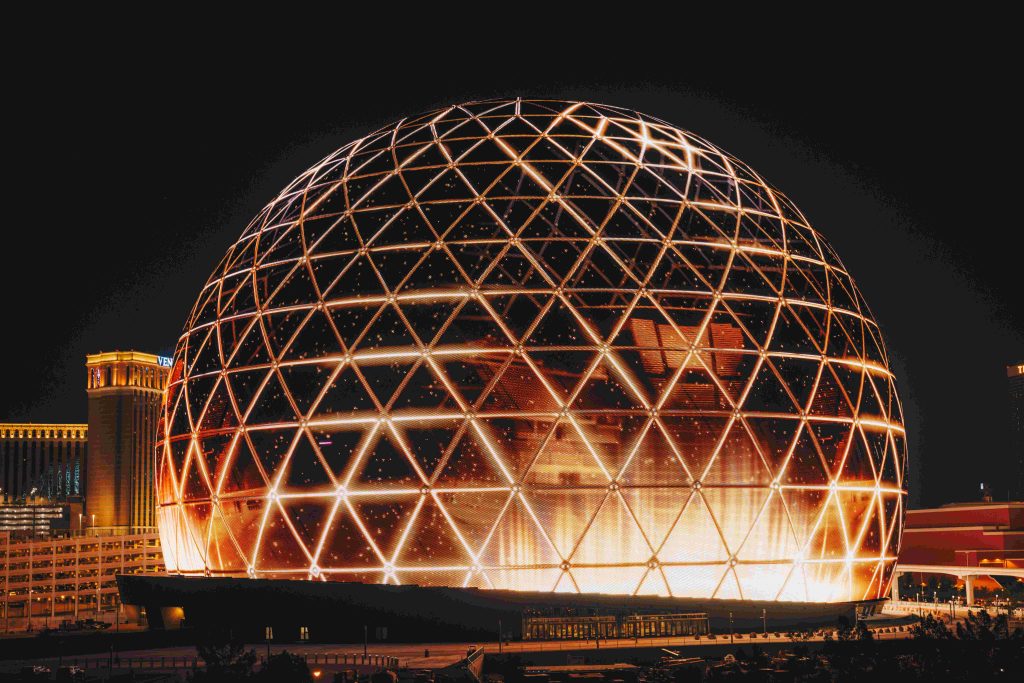Sphere
October 30, 2023Sphere, the next-generation entertainment venue located on Sands Avenue east of the Strip in Las Vegas, Nevada, officially opened at the end of September. A 516-ft-diameter semi-spherical building rising 366 ft above ground, Sphere encloses a bowl-shaped theater for 17,600 guests, seated beneath a domed roof and suspended media plane. Severud Associates has been involved as the structural engineer of Sphere—since the project’s inception—and the venue is now the largest spherical structure in the world.
The feature Sphere visitors encounter first is the Exosphere, the venue’s outer latticed grid shell, composed of steel pipe sections and cast steel connecting nodes and covered with 580,000 sq ft of programmable LED lighting, which can present stunning visual displays. Starting from a traditional geodesic arrangement—a “Bucky dome,” as envisioned by Buckminster Fuller—Severud’s structural engineers employed parametric design and optimization to determine the lightest tessellation of the sphere.
Then, working in collaboration with the Sphere team, architect, and steel contractor, they studied several alternate configurations that would be visually appealing while facilitating fabrication and erection. The team finally arrived at a hybrid solution of horizontal “latitudes” of continuous ring members and crisscrossing diagonal geodesic elements, continuous between the pile-supported grade beam at its base and a latitudinal ring near the crown. The topmost framing, known as the Oculus, is framed radially.
Severud and the team next studied node connection details, bringing in a casting contractor to advise on cast steel nodes. Two designs based on welded plates were compared to castings with flanges, with a focus on cost and schedule. Extensive analysis revealed that built-up plate nodes presented daunting constructability issues. Cast steel nodes, on the other hand, offered significant advantages of material optimization, improved tolerances, and reduced construction risk. The cast nodes also have a cleaner look and all appear essentially identical.
Inside the venue, guests experience the awe-inspiring immersive theater—some call it virtual reality without the headset—which is created from separate layered structural systems. The lower seating bowl framing, stage and proscenium, and back of house components are reinforced concrete members bearing on concrete piles and mats. The upper seating framing and perimeter catwalks are structural steel in a barrel-shaped arrangement. All seats—10,000 of which are immersive and include haptic systems—are supported on precast concrete stadia. Topping off the theater is an optimized steel-framed dome.
Although Sphere is composed of distinct structural systems, they are all interconnected to form a cohesive, balanced, efficient, and elegant superstructure. Constructed under continuous and careful supervision over the course of five years, this amazing performance space was envisioned to create a fully immersive experience and elevate the entertainment venue to the next level. Thanks to the collaboration and creative thinking applied to its design and construction, Sphere advances the state of the art of structural engineering as well.
Severud Associates has a 95-year history of turning its clients’ most ambitious visions into reality. In addition to Sphere, the firm’s portfolio of special structures includes Madison Square Garden, in New York City; the fabric roof and glass walls of the Jeppesen Terminal at Denver International Airport in Colorado; and the Gateway Arch at the Jefferson National Expansion Memorial in St. Louis, Missouri.
